ViewSonic AV802G 802.11g WLAN Mini PCI User Manual
ViewSonic Corporation 802.11g WLAN Mini PCI
Contents
- 1. User Manual
- 2. OEM Installation Guide
User Manual

8
80
02
2.
.1
11
1g
g
W
WL
LA
AN
N
M
Mi
in
ni
i
P
PC
CI
I
AV802G
Quick Start Guide
Version 1.0

1
No part of this documentation may be reproduced in any form or by any means or used to make any
derivative work (such as translation, transformation, or adaptation) without written permission from
the copyright owner.
All the other trademarks and registered trademarks are the property of their respective owners.
Statement of Conditions
We may make improvements or changes in the product described in this documentation at any time. The
information regarding to the product in this manual are subject to change without notice.
We assume no responsibility for errors contained herein or for direct, indirect, special, incidental, or
consequential damages with the furnishing, performance, or use of this manual or equipment supplied with it,
even if the suppliers have been advised of the possibility of such damages.
Electronic Emission Notices
This device complies with Part 15 of the FCC Rules. Operation is subject to the following two conditions:
(1)This device may not cause harmful interference.
(2)This device must accept any interference received, including interference that may cause undesired
operation.
FCC INFORMATION
The Federal Communication Commission Radio Frequency Interference Statement includes the following
paragraph:
The equipment has been tested and found to comply with the limits for a Class B Digital Device, pursuant to
part 15 of the FCC Rules. These limits are designed to provide reasonable protection against harmful
interference in a residential installation. This equipment generates, uses and can radiate radio frequency
energy and, if not installed and used in accordance with the instruction, may cause harmful interference to
radio communication. However, there is no guarantee that interference will not occur in a particular installation.
If this equipment does cause harmful interference to radio or television reception, which can be determined by
turning the equipment off and on, the user is encouraged to try to overcome the interference by one or more of
the following measures:
--Reorient or relocate the receiving antenna.
--Increase the separation between the equipment and receiver.
--Connect the equipment into an outlet on a circuit different from that to which the receiver is connected.
--Consult the dealer or an experienced radio/TV technician for help.
The equipment is for home or office use.
IMPORTANT NOTE
FCC RF Radiation Exposure Statement: This equipment complies with FCC RF radiation exposure limits set
forth for an uncontrolled environment. This equipment should be installed and operated with a minimum
distance of 20cm between the antenna and your body and must not be co-located or operating in conjunction
with any other antenna or transmitter.
Caution: Changes or modifications not expressly approved by the party responsible for compliance
could void the user's authority to operate the equipment.

2
R&TTE Compliance Statement
This equipment complies with all the requirements of the Directive 1999/5/EC of the European parliament and
the council of 9 March 1999 on radio equipment and telecommunication terminal Equipment and the mutual
recognition of their conformity(R&TTE).
The R&TTE Directive repeals and replaces in the directive 98/13/EEC. As of April 8, 2000.
Canada IC Compliance Statement
Low Power License-Exempt Radio communication Devices (RSS-210)
1. Warning Note: Operation is subject to the following two conditions: (1) this device may not cause
interference, and (2) this device must accept any interference, including interference that may cause
undesired operation of the device.
2. Operation in 2.4GHz band: To prevent radio interference to the licensed service, this device is intended
to be operated indoors and away from windows to provide maximum shielding. Equipment (or its transmit
antenna) that is installed outdoors is subject to licensing.
Exposure of Humans to RF Fields for module built-in mobile Radios Equipment (RSS-102)
1. Mobile radios that are not body worn (e.g. mounted on vehicles or placed on desks, shelves, etc.) and
operated such that humans are normally separated from their radiating element by at least 20 cm
are not subject to SAR tests, but must have an RF evaluation by the certification applicant, based on the
calculated or measured field strength value. SAR evaluation can be used if so desired in lieu of a RF
evaluation of field strength limits.
2. Exposures produced by such radios shall not exceed the exposure limits specified in Health Canada's
Safety Code 6. Health Canada’s address is :775 Brookfield Road, Ottawa, Ontario Canada K1A 1C1; Tel:
(613) 954-6699 / Fax:(613) 941-1734 ;
e-mail: alice_mackinnon@hc-sc.gc.ca.

T
Ta
ab
bl
le
e
o
of
f
C
Co
on
nt
te
en
nt
ts
s
INTRODUCTION ...........................................................................................................................................1
1.1 Features.................................................................................................................................. 1
1.2 System Requirements ............................................................................................................ 1
INSTALLATION.............................................................................................................................................2
2.1 Installation Procedures ........................................................................................................... 2
Confirm the Hardware Connection...........................................................................................................2
Installation Procedures.............................................................................................................................3
2.2 Installation Notes - Windows XP.............................................................................................5
2.3 Verifying a Successful Installation .......................................................................................... 7
APPENDIX A: TROUBLESHOOTING .......................................................................................................9
The 802.11g WLAN Mini PCI Does Not Work Properly.............................................................. 9
Disable the 802.11g WLAN Mini PCI .......................................................................................... 9
Uninstall WLAN 54Mbps Configuration Tool and the Card’s Driver .............................................. 9
APPENDIX B: SPECIFICATIONS.............................................................................................................12

L
Li
is
st
t
o
of
f
F
Fi
ig
gu
ur
re
es
s
FIGURE 2.1-1: THE DEVICE MANAGER SCREEN BEFORE INSTALLATION ........................................................2
FIGURE 2.1-2: THE FOUND NEW HARDWARE WIZARD DIALOG BOX.............................................................3
FIGURE 2.1-3: THE START-UP SCREEN ...............................................................................................................3
FIGURE 2.1-4: THE WELCOME TO THE INSTALLSHIELD WIZARD WINDOW..................................................4
FIGURE 2.1-5: THE WINDOWS XP SYSTEM COMPATIBILITY TESTING WARNING MESSAGE .............................4
FIGURE 2.1-6: THE INSTALL FINISHED SCREEN ...............................................................................................5
FIGURE 2.1-7: THE INSERT DISK MESSAGE BOX IN WINDOWS 98 SYSTEM.....................................................5
FIGURE 2.2-1: THE WLAN 54MBPS CONFIGURATION TOOL TRAY ICON ......................................................6
FIGURE 2.2-3: THE WIRELESS NETWORK CONNECTION STAT U S DIALOG BOX ............................................6
FIGURE 2.2-4: THE WIRELESS NETWORK CONNECTION PROPERTIES DIALOG BOX....................................7
FIGURE 2.3-1: THE DEVICE MANAGER DIALOG BOX ......................................................................................8
FIGURE 5-1: THE WLAN 54MBPS CONFIGURATION TOOL UNINSTALL COMMAND....................................10
FIGURE 5-2 THE WLAN 54MBPS CONFIGURATION TOOL REMOVAL WARNING MESSAGE.........................10
FIGURE 5-3 THE UNINSTALL FINISHED SCREEN ............................................................................................ 11

1
INTRODUCTION
Being five times faster than the speed of 802.11b network standard devices, the innovative 802.11g
standard lets the wireless network become incredibly easier and faster (up to 54Mbps) than ever.
Your 802.11g WLAN Mini PCI surely will bring you into such a high-speed network sphere. This
document describes how to install your 802.11g WLAN Mini PCI , which aims to let your computer
quickly and seamlessly communicate with 802.11 networks. WLAN is local area networking without
wires, which uses radio frequencies to transmit and receive data between PCs or other network
devices. Additionally, wireless LAN is able to configure either independent networks, which is also
known as peer-to-peer or ad-hoc network, or infrastructure networks. The former is suitable for
small or temporary peer-to-peer configurations, and the later is offering fully distributed data
connectivity via micro cells and roaming.
To obtain most benefits your 802.11g WLAN Mini PCI brings, please read this manual carefully
before using it.
1.1 Features
With 802.11g WLAN Mini PCI , you can:
establish a wireless connection without the hassles and cost of cabling
operate Ad-Hoc or Infrastructure mode
utilize up to 128-bit WEP encryption
enjoy high-speed data transfer rate up to 54 Mbps
employ automatic data rate switching which offers maximum reliability, throughput and
connectivity
possess the network’s range up to 100 meters indoor and 400 meters outdoor
monitor and configure the network via the supplied friendly-interfaced application –
WLAN 54Mbps Configuration Tool
1.2 System Requirements
To properly operate your Card, your computer should meet the following minimum requirements:
Microsoft Windows 98/98 Second Edition/Me/2000 or Windows XP
Minimum 5 Mbytes free disk space for installing the driver and the utility program
32 MB RAM or above
A CD-ROM drive
300 MHz processor or higher
Mini-PCI interface
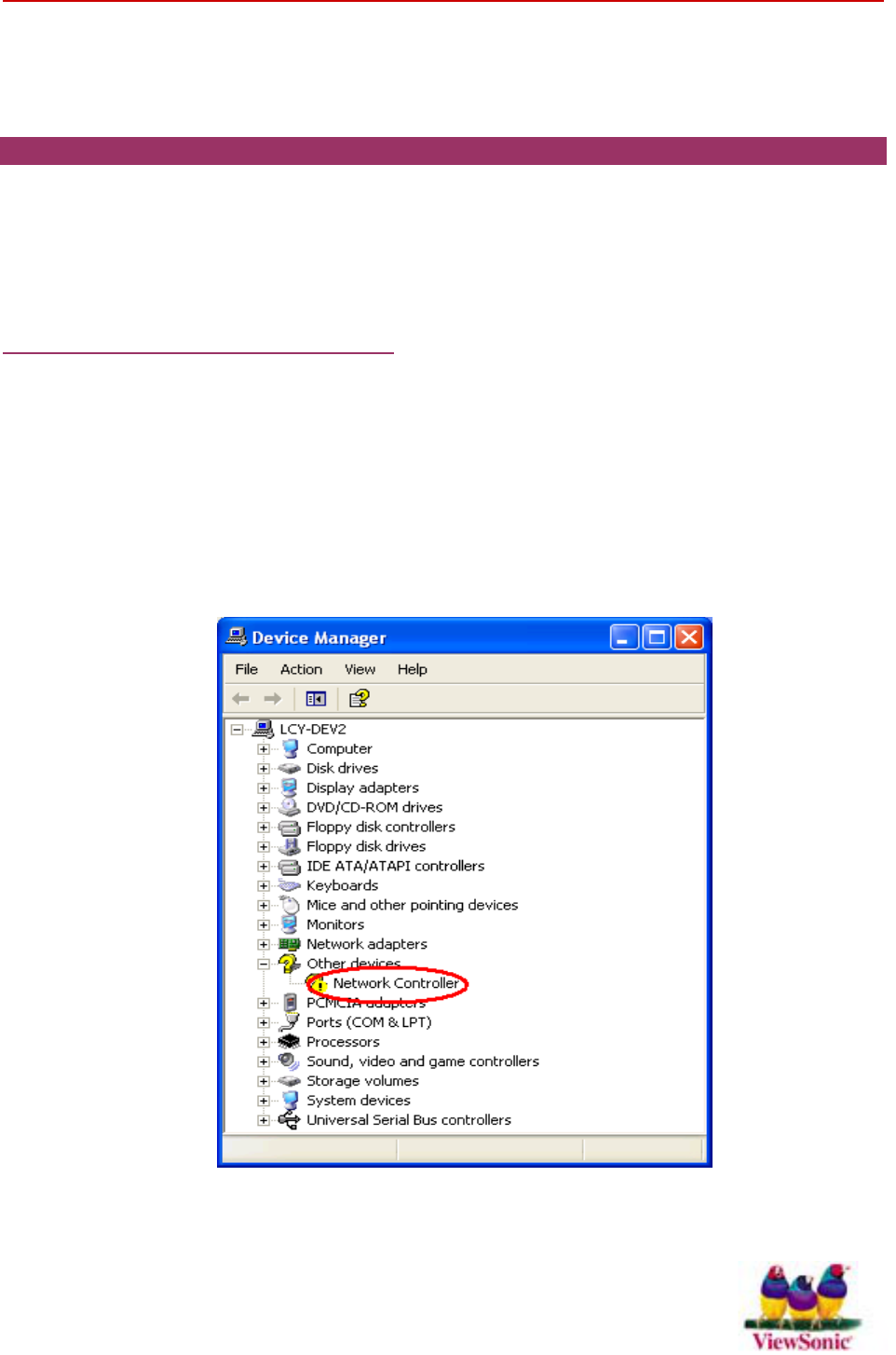
2
INSTALLATION
It’s free and easy for you to install your 802.11g WLAN Mini PCI and the attached software –
WLAN 54Mbps Configuration Tool. Simply with a few clicks of the mouse, you will succeed the
installation.
2.1 Installation Procedures
To have the 802.11g WLAN Mini PCI operated appropriately, please read and go along with the
step-by-step instructions below carefully. Here we take the installation on Windows XP operating
system as the standard flow. The flow might be slightly different while installing it on different
version of Windows, and these differences have been highlighted under the corresponding steps.
Confirm the Hardware Connection
a) Right-click My Computer desktop icon and choose Properties from the opened menu.
b) In the System Properties dialog box, select the Hardware Device tab, and then click
the Device Manager button.
c) In the opened window, expand the Other devices item, if there is an unknown Network
Controller displayed, the hardware has been built inside your computer system and
you may go along with the steps below now. If the device has not been displayed,
please contact your distributor.
Figure 2.1-1: The Device Manager Screen Before Installation
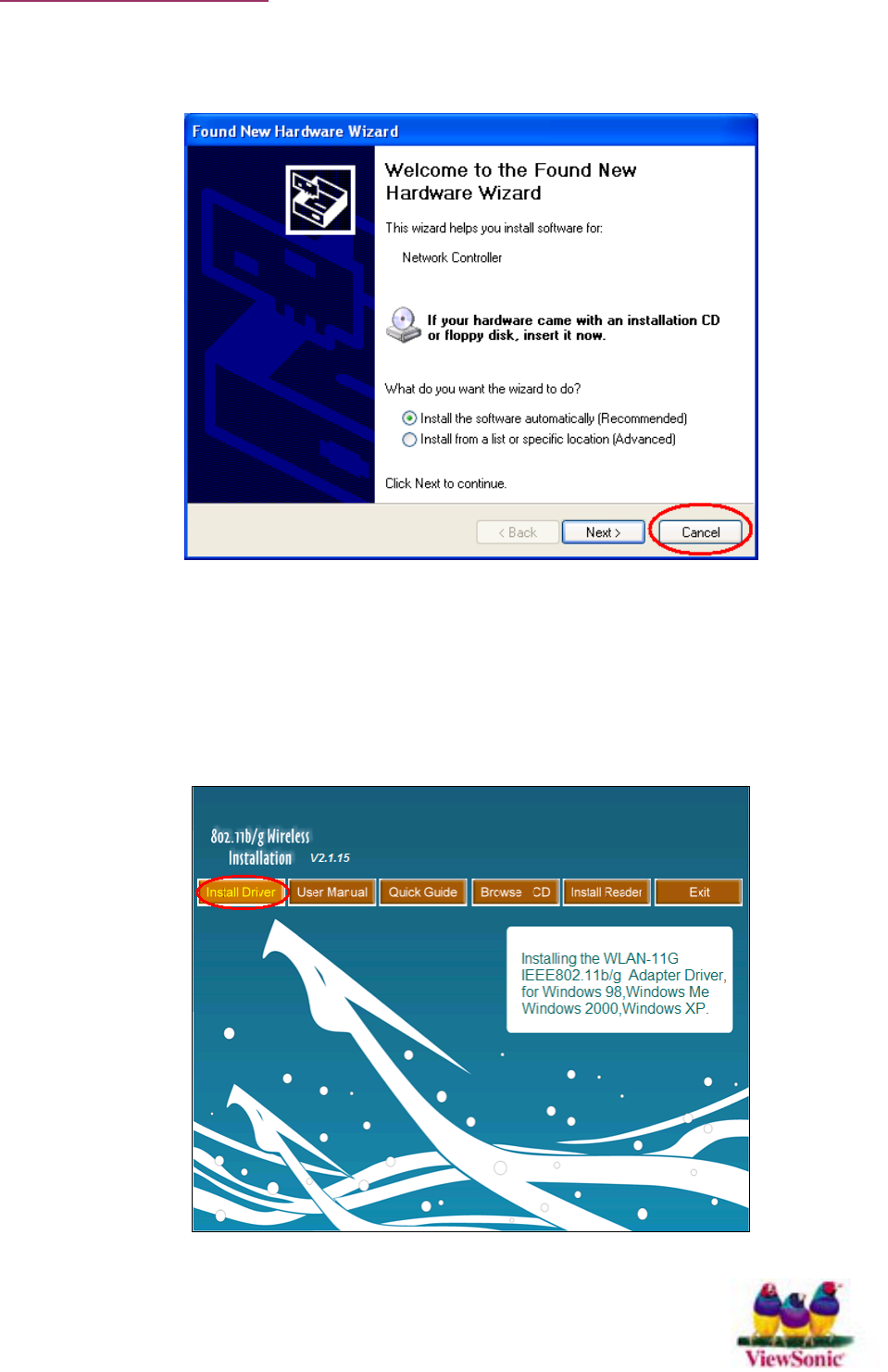
3
Installation Procedures
a) Once your system detects the device, the Found New Hardware Wizard dialog box
shall appear. Choose Cancel to proceed.
Figure 2.1-2: The Found New Hardware Wizard Dialog Box
b) Insert the supplied Setup CD to your CD-ROM drive, and the Setup Wizard will run
automatically. If it does not, please manually execute Autorun.exe in the CD’s
directory.
c) From the prompted start-up screen, choose Install Driver to begin the installation.
Figure 2.1-3: The Start-up Screen
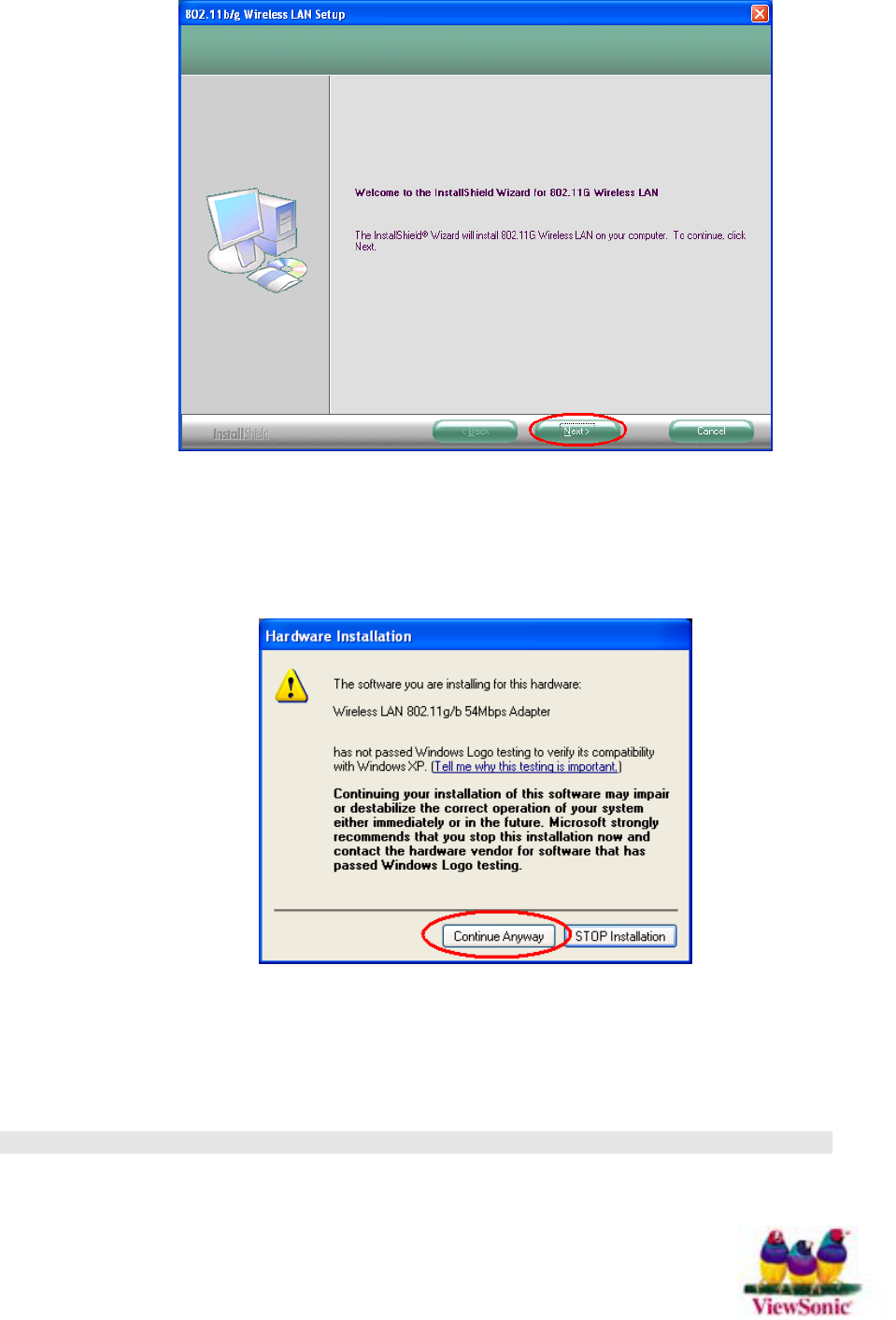
4
d) Click Next in the Welcome to the InstallShield Wizard window to proceed. The
system will start to copy the drivers found.
Figure 2.1-4: The Welcome to the InstallShield Wizard Window
e) Windows may notify you with message box below that the driver has not passed
Windows Logo testing. Because the Card has been tested to work with Windows XP,
please choose Continue Anyway to ignore it.
Figure 2.1-5: The Windows XP System Compatibility Testing Warning Message
f) On the Install Finished screen, click Finish to complete the installation. Note that
when you are running Win98/98SE/ME, the computer will restart automatically after
clicking Finish.
Note: It is necessary for Win98/98se/ME users to restart the computer for completing the installation.
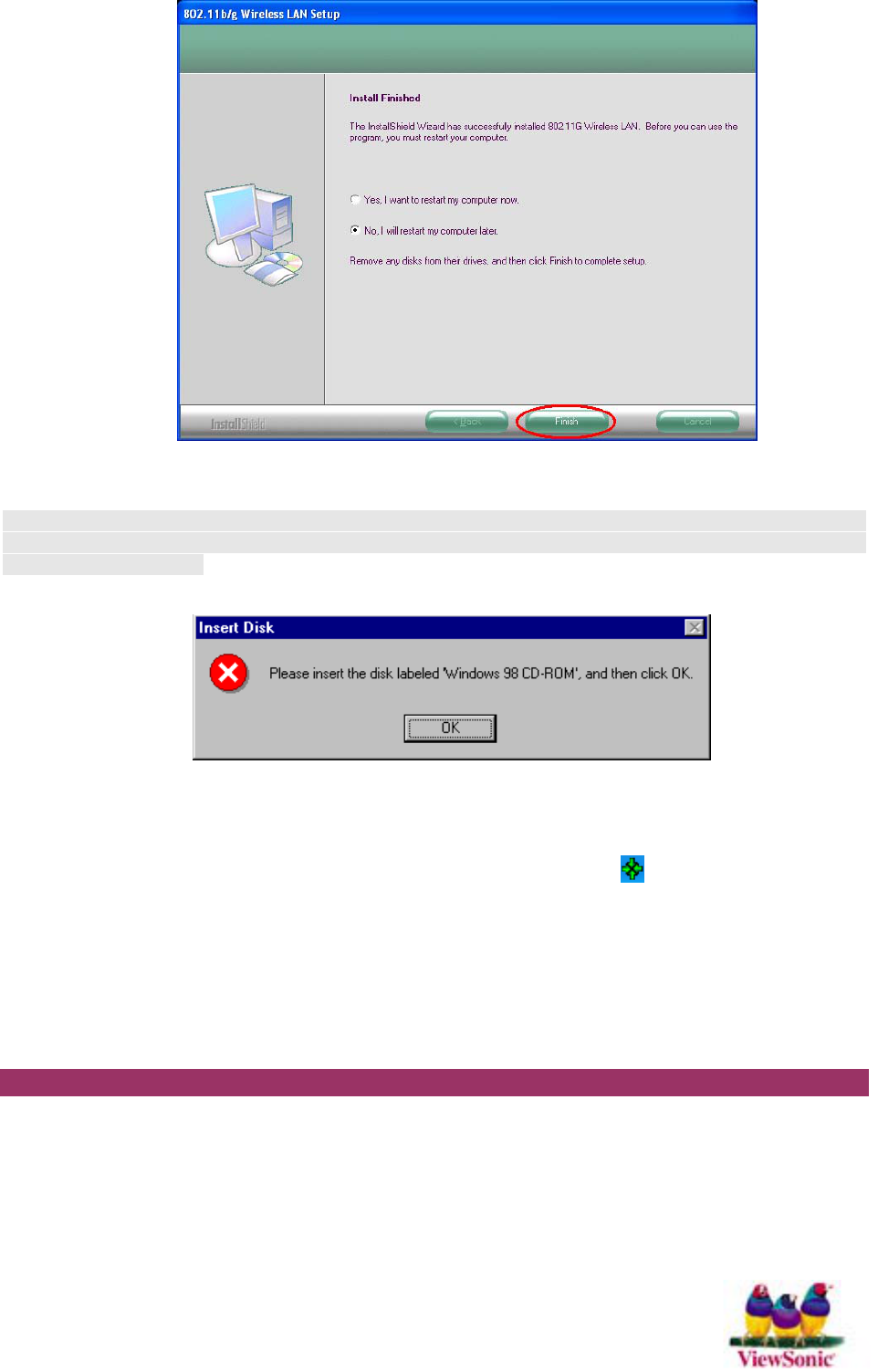
5
Figure 2.1-6: The Install Finished Screen
Note: For Win 98 users, the system may ask for Windows 98 CD-ROM after rebooting. Please replace the
supplied CD with the required one and click OK to proceed. Then please follow the on-screen instructions to
complete the installation.
Figure 2.1-7: The Insert Disk Message Box in Windows 98 System
Now you shall find the WLAN 54Mbps Configuration Tool tray icon, , appeared in the system
tray. The installation is entirely finished at this moment.
Double-click the icon is able to launch the application and open the WLAN 54Mbps Wireless
Settings dialog box, in which you may freely arrange your network connection afterwards.
2.2 Installation Notes - Windows XP
If your system is running Windows XP, you shall find three tabs displayed in the WLAN 54Mbps
Wireless Settings configuration interface after you’ve followed the instructions above and
successfully installed the drivers and utility. However, normally, the dialog box should be
consisted of six tabs. This is because Windows XP has its built-in configuration tool – Wireless
Zero Configuration to assist you in wireless networking activities. It is recommended to
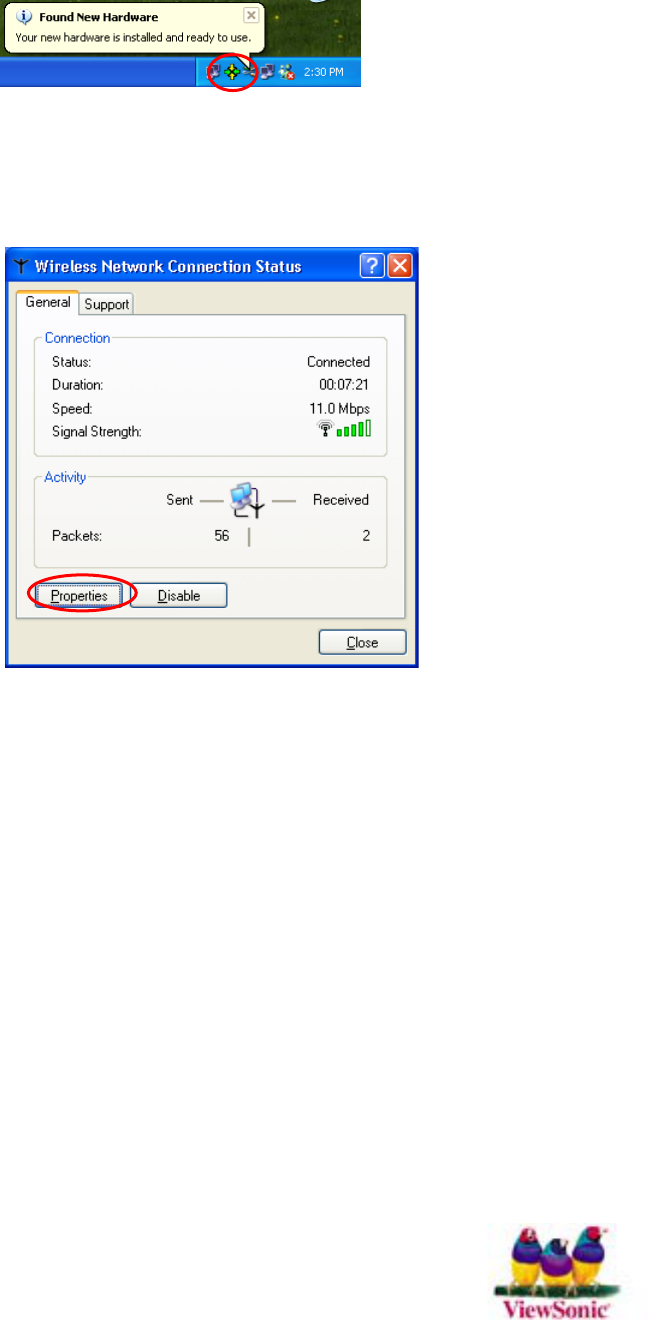
6
utilize the attached WLAN 54Mbps Configuration Tool to enjoy more benefits it will bring.
Thus, to employ your WLAN 54Mbps Configuration Tool under Windows XP, please proceed to
the following procedures to change the default settings of Wireless Zero Configuration to
enable WLAN 54Mbps Configuration Tool.
Figure 2.2-1: The WLAN 54Mbps Configuration Tool Tray Icon
a) Double-click the Network Connections icon at the task bar to open the Wireless
Network Connection Status dialog box, and then select Properties.
Figure 2.2-2: The Wireless Network Connection Status Dialog Box
b) Open the Wireless Networks menu, and remove the tick from the Use Windows to
configure my wireless network settings checkbox.
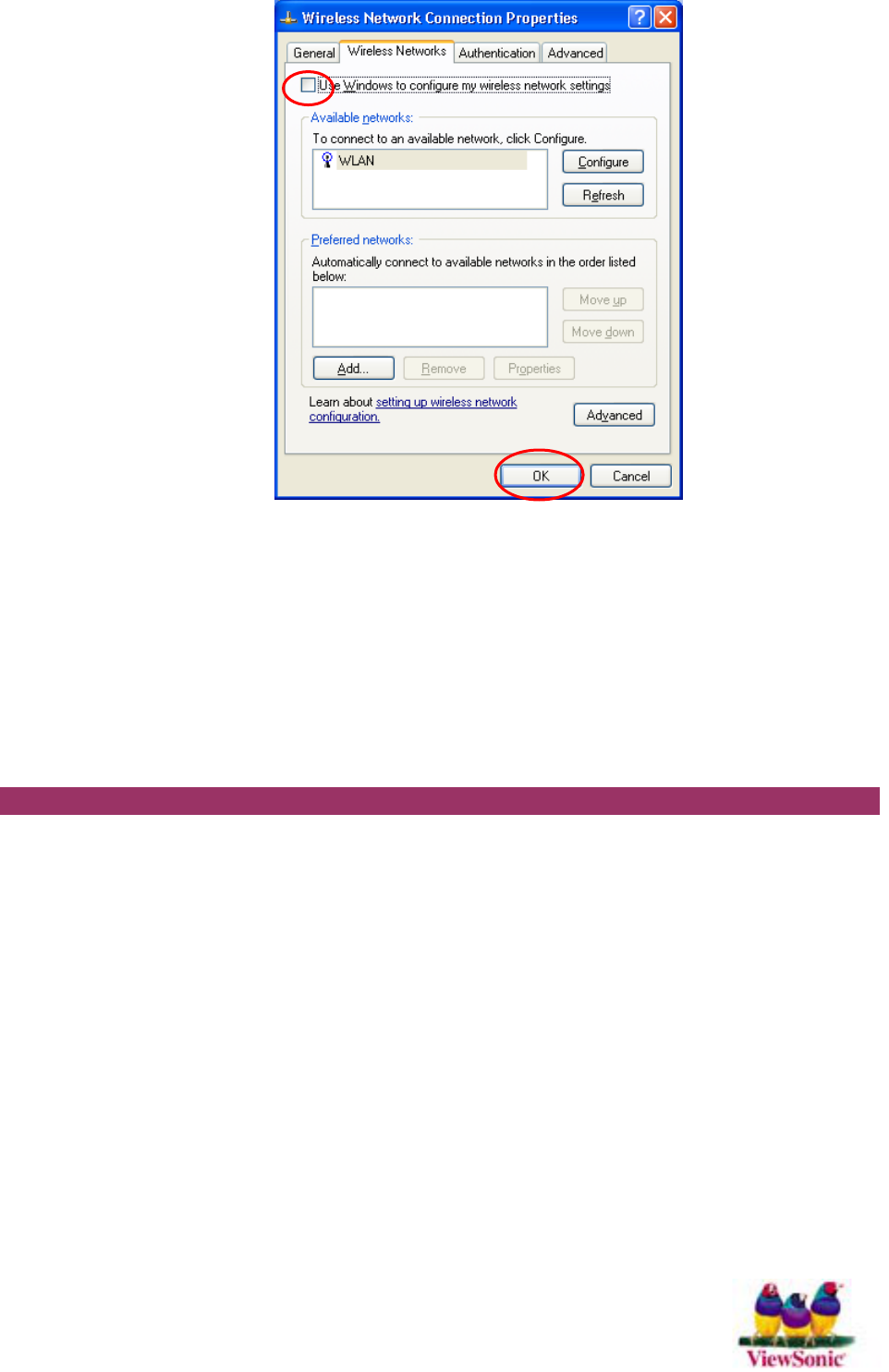
7
Figure 2.2-3: The Wireless Network Connection Properties Dialog Box
c) Click OK. Now, you have successfully disabled the Wireless Zero Configuration.
To monitor and configure the network via WLAN 54Mbps Configuration Tool, double-click its
tray icon, and you shall find six tabs contained in the popped up configuration interface this time.
2.3 Verifying a Successful Installation
To confirm that the 802.11g WLAN Mini PCI is properly installed, please follow the procedures
below:
1. Right-click My Computer desktop icon and choose Properties from the opened menu.
2. In the System Properties dialog box, select the Hardware Device tab, and then click
the Device Manager button.
3. In the opened window, expand Network adapters to find the Adapter – Wireless LAN
802.11g/b 54Mbps Adapter. Right-click over the item and choose Properties.
4. Select the General tab from opened dialog box, find the descriptions under the Device
Status pane to check if the Card is working properly. However, if there’s an error
message such as a red or yellow question mark attached aside, please uninstall the
Card, restart your system, and go through the installation procedures again.
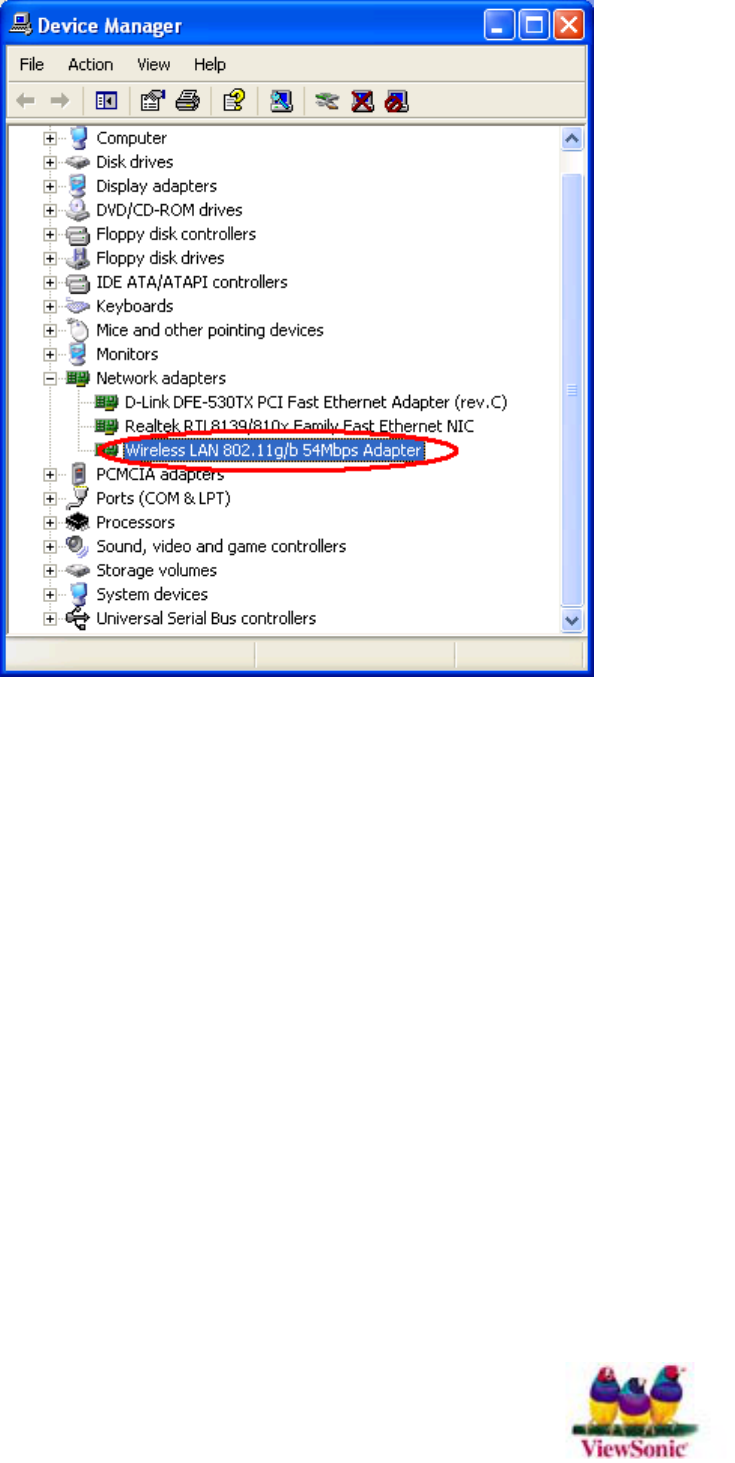
8
The following picture indicates a successful installation of 802.11g WLAN Mini PCI .
Figure 2.3-1: The Device Manager Dialog Box

9
APPENDIX A: TROUBLESHOOTING
This section provides solutions to problems that you might encounter during the installation and
operation of your 802.11g WLAN Mini PCI . Please refer to the desired topics below and read the
description to solve your problems.
The 802.11g WLAN Mini PCI Does Not Work Properly
If this happens, follow the guidelines below.
Right-click the My Computer desktop icon and choose Properties to open the System
Properties dialog box. If you are under Windows 98/Me, choose the Device Manager tab, or if
you are running Windows 2000/XP, click the Hardware tab, and then choose the Device
Manager button. In the opened window, find your Mini PCI Card to see if the installation is
successful. If you see a yellow exclamation mark beside the item, please heading to following
steps to reinstall the drivers:
1. Uninstall the software and hardware drivers from your PC. (Please refer to the Uninstall
WLAN 54Mbps Configuration Tool and the Card’s Driver section for details)
2. Restart your computer and repeat the installation procedures as indicated in section 2.1
of this manual.
3. When finished, open the Device Manager window again to verify if the installation is
approved. The yellow exclamation mark shall be removed this time.
Disable the 802.11g WLAN Mini PCI
Supposed you do not need the 802.11g WLAN Mini PCI to establish the wireless connectivity for
any reason, click Disable Radio on the Status tab of the WLAN 54Mbps Wireless Settings
dialog box. Thus, be sure that you have closed all network applications before disable the device.
Uninstall WLAN 54Mbps Configuration Tool and the Card’s Driver
Prior to starting uninstalling, please make sure that the utility is closed. To remove the WLAN
54Mbps Configuration Tool and the Card’s driver, please check the following introductions for
details.
1. Execute the uninstall command by selecting WLAN 54Mbps Uninstall from the
submenu of WLAN 54Mbps TOOLS in the Program menu provoked by clicking Start
button on the task bar.
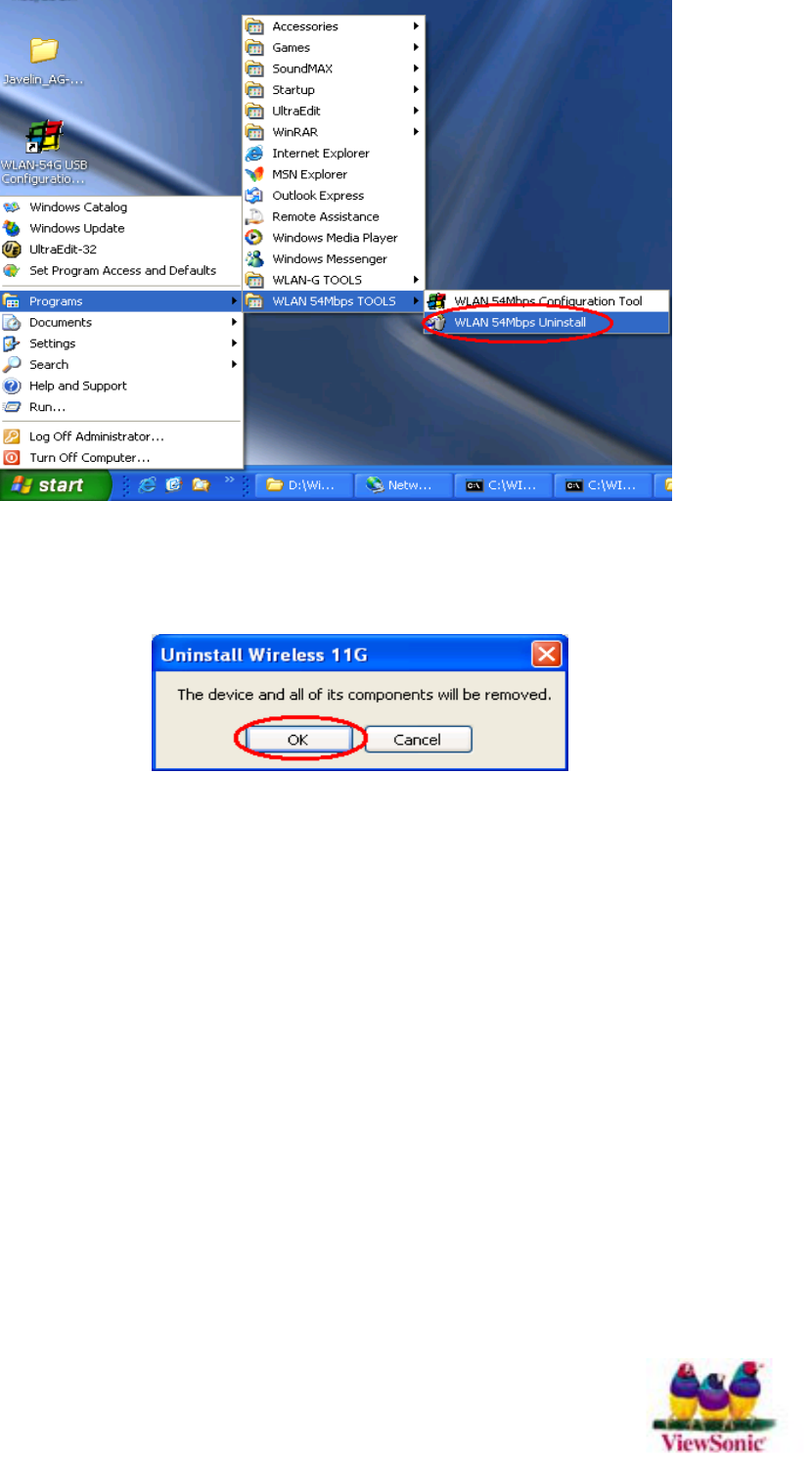
10
Figure 5-1: The WLAN 54Mbps Configuration Tool Uninstall Command
2. Choose OK when the following message box appears to proceed.
Figure 5-2 The WLAN 54Mbps Configuration Tool Removal Warning Message
3. Click Finish in the Uninstall Finished dialog box to complete the removal. Note that if
you are running Win98/98SE/ME, the computer will restart automatically after clicking
Finish.

11
Figure 5-3 The Uninstall Finished Screen

12
APPENDIX B: SPECIFICATIONS
Product Name 802.11g WLAN Mini PCI
Host Interface Mini-PCI
Standards IEEE 802.11, IEEE 802.11b, IEEE 802.11g
Frequency Band 2.4G ISM-band (subject to local regulations)
Subject to local
regulations
USA /Canada/Taiwan: 2400~2483.5MHz(Ch1~Ch11)
Europe (ETSI 300 328): 2400~2483.5MHz(Ch1~Ch13)
Japan:
ARIB STD-T66: 2400~2483.5MHz(Ch1~C13)
ARIB STB-33: 2471~2497MHz(Ch14)
Current Drain Power save mode=22mA, Standby mode=7mA, Transmit mode=460mA,
Receive mode=410mA
Spreading DSSS (11b), OFDM (11g)
Data Rate 1Mpbs, 2Mbps, 5.5Mbps, 6Mbps, 9Mbps, 11Mbps, 12Mbps, 18Mbps,
24Mbps, 36Mbps, 48Mbps, 54Mbps
Transmit Power 802.11b≧17dBm
802.11g
6/9Mbps≧17dBm
12/18Mbps≧15dBm
24Mbps≧14dBm
36Mbps≧14dBm
48Mbps≧12dBm
54Mbps≧12dBm
Receive Sensitivity 802.11b
8% FER@1Mbps≦-91dBm
8% FER@2Mbps≦-88dBm
8% FER@5.5Mbps≦-85dBm
8% FER@11Mbps≦-83dBm
802.11g
10% PER@6Mbps≦-88dBm
10% PER@9Mbps≦-87dBm
10% PER@12Mbps≦-84dBm
10% PER@18Mbps≦-82dBm
10% PER@24Mbps≦-79dBm
10% PER@36Mbps≦-75dBm
10% PER@48Mbps≦-69dBm
10% PER@54Mbps≦-68dBm

13
Modulation CCK (11b), BPSK, QPSK, 16-QAM, 64-QAM (11g)
Security 64/128 bit WEP Encryption
802.1x, WPA (Windows XP SP1 and Windows 2000 SP4 only)
Internal Antenna Type Dual Antenna Diversity Switching
Media Access Control RF activity
Supplied Driver CSMA/CA with ACK
Warranty 1 year
Temperature Range 0~65°C (Operating)
Humidity Max. 95% Non-condensing
Operating Range Open Space: up to 400meters; Indoor: up to 100meters
The transmission speed varies in the surrounding environment.
CIS Customer Defined